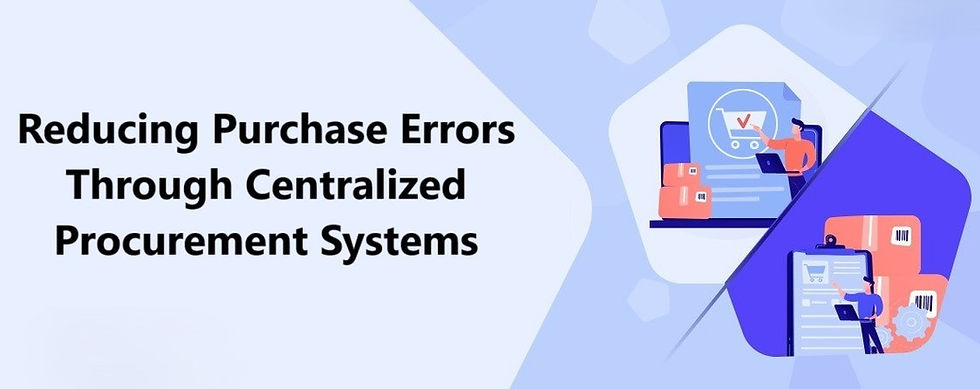Reducing Purchase Errors Through Centralized Procurement Systems
- Om Modi
- Dec 18, 2024
- 3 min read
In the fast-paced world of the food and beverage (F&B) industry, efficient procurement is essential for minimizing purchase errors, controlling costs, and ensuring consistent quality. One way restaurants can reduce these errors and streamline operations is by implementing a centralized procurement system. With the right inventory management software, businesses can optimize purchasing, manage stock levels, and ensure timely deliveries, all while minimizing costly mistakes that can impact the bottom line.

The Role of Centralized Procurement Systems in Reducing Errors
Centralized procurement systems consolidate the entire purchasing process into a single, easy-to-manage interface. This centralization reduces the chances of errors by ensuring consistent data entry, standardized processes, and improved communication across departments. With automated inventory tracking for restaurants and bars, procurement becomes more accurate, allowing for real-time monitoring of stock levels, supplier performance, and purchasing trends.
A cloud-based inventory solution enables seamless integration with other F&B order tracking systems, providing a single source of truth. This integration ensures that inventory is continuously updated, allowing staff to make informed decisions when ordering ingredients or supplies.
Key Benefits of Centralized Procurement for Reducing Errors
Improved Data Accuracy: Centralized systems help eliminate discrepancies between purchase orders, invoices, and inventory levels. By integrating procurement with inventory management software for restaurants, businesses can automatically update stock levels in real-time, reducing human error.
Better Supplier Management: A supplier management system for restaurants allows businesses to track performance, monitor delivery schedules, and identify reliable suppliers. This reduces the risk of receiving incorrect or substandard products, ensuring that only quality ingredients are ordered and delivered.
Enhanced Purchase Planning: With inventory forecasting tools and demand forecasting for restaurants, businesses can predict future needs and align purchasing schedules with demand trends. This predictive analytics for restaurant inventory helps prevent overstocking and understocking, ensuring that the kitchen always has the right amount of ingredients without excess waste.
Streamlined Communication: Centralized procurement systems also improve communication between purchasing and kitchen staff. Real-time cost analysis tools for restaurant operations and integrated systems ensure that everyone is on the same page, reducing the risk of errors due to miscommunication.
Integrating Technology to Maximize Efficiency
Implementing a POS-integrated inventory system ensures that purchases align with actual sales data, providing businesses with up-to-date information on stock movements. This helps avoid ordering errors and unnecessary purchases. For example, just-in-time inventory systems for F&B help restaurants maintain lean operations by ordering ingredients only when necessary, minimizing storage costs and waste.
Additionally, automated reordering systems can trigger purchase orders when stock levels fall below predefined thresholds. This helps eliminate the need for manual stock checks and reduces the likelihood of ordering mistakes.
Minimize Food Waste and Spoilage
One of the most significant challenges in F&B procurement is managing perishable goods. Centralized procurement systems equipped with batch tracking for perishable goods and FIFO inventory systems for F&B help businesses track the shelf life of ingredients, reducing spoilage and waste. By managing stock based on expiration dates, restaurants can ensure that products are used in the correct order, minimizing food wastage and optimizing profit margins.
Furthermore, spoilage reduction software can help businesses track spoilage patterns and identify potential issues before they become significant losses. This can help optimize inventory and reduce the costs associated with waste.
Real-Time Monitoring and Inventory Optimization
With inventory dashboards for restaurants and real-time ingredient monitoring, restaurant owners and managers can keep track of stock movements and make informed purchasing decisions. Real-time stock tracking allows for better decision-making, helping businesses optimize their purchasing processes and reduce errors in procurement.
Using inventory automation for F&B not only improves accuracy but also ensures that the right products are ordered at the right time. The integration of AI-driven inventory management tools can further enhance procurement by predicting demand, optimizing stock levels, and reducing human intervention in the purchasing process.
Conclusion
By leveraging a centralized procurement system, restaurants and F&B businesses can significantly reduce purchase errors, improve efficiency, and streamline their operations. Integrating inventory management solutions for the food and beverage industry with real-time tracking and automated systems can help reduce waste, optimize ordering, and manage costs more effectively. As the F&B industry continues to evolve, investing in technology-driven procurement solutions will be key to staying competitive and maintaining operational efficiency.
At Barometer Technologies, we offer advanced inventory management solutions that help streamline your procurement process, reduce purchase errors, and optimize stock levels in your restaurant. Our cloud-based inventory solutions and cost management tools for restaurants ensure that your operations run smoothly and efficiently. Ready to boost your procurement accuracy? Schedule a demo with us today and discover how our tailored solutions can support your F&B business.



Comments